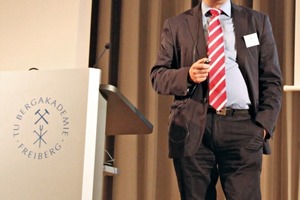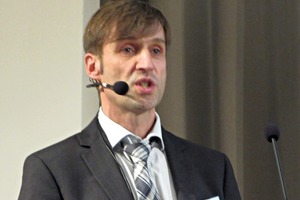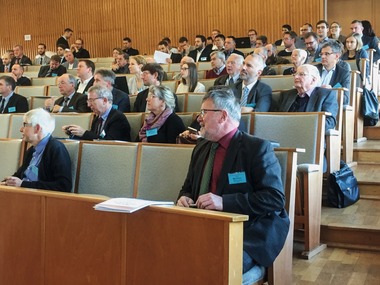Traditional “Processing and Recycling” conference with record attendance – Part 2
3 Processing of secondary resources
The sorting of materials groups recyclable via the materials route from mixtures of waste has been state-of-the-art for around thirty years. The paper entitled “Technical and economic success of sorting of useful materials” by Dipl.-Ing. Bauerschlag and Prof. Pretz (RWTH Aachen University) focused on the questions of preconditioning prior to the use of sensor-assisted sorting systems, process cycle and depth of sorting. The process-engineering results are compared, in a microeconomic context, in particular, on the basis of a range of mathematically evaluated sorting processes. One problem perceived in this context is the fact that the risks arising from the customary short contract periods, and also volatile prices for sorted products, are a brake on investments in technologies offering a high depth of sorting, despite the fact that these are necessary to achieve resources efficiency.
The joint “Lights recycling” project conducted by machinery and plant engineer Schulz & Berger Luft- und Verfahrens-technik GmbH, Altenburg, and the Nordhausen University of Applied Sciences, has resulted in the development of an innovative system which was the subject of the paper entitled “Bag openers, separators & Co. – New directions in recycling technology” by M. Eng. Borowski (Nordhausen University of Applied Sciences). This permits non-contact bag opening by means of a pulse of compressed air followed by the removal of films by means of a vacuum separator. The films are suction-captured on the perforated surface of a drum and then conveyed away. Lumpy contents, such as cans, beakers and bottles, are not captured by the drum, and are extracted separately. A range of settings make it possible to adapt the vacuum separator for processing of a range of differing waste compositions. New dedusting concepts for surface filtration have also been tested for the cleaning of dust-laden air and the recovery of airborne useful materials.
The paper “Processing of aluminium salt slags” by Dipl.-Ing. Gerhard Merker (Merker-Mineral-Processing, Schwerte), Dr.-Ing. Bruch (ScholzAlu Trading GmbH, Essingen) and Dr.-Ing. Buntenbach (TriMin Consulting, Ammerthal) featured each of the three authors speaking on their specialist field. Aluminium salt slags are generated in melting of scrap and dross under a layer of molten salt. They consist essentially of metallic aluminium, melting salt, oxidic constituents (aluminium oxides, in particular) and various impurities. Following an introduction to the basic principles of aluminium recycling, the status of the processing of salt slags from melting of Al scrap and Al dross was examined, and the essential criteria in the valorisation of the resultant recycling products, and of the so-called oxides, in particular, illustrated with selected examples.
The paper entitled “Mechanical accessing in the recycling of lithium-ion batteries” by Dipl.-Ing. Diekmann, Dipl.-Ing. Hanisch, Prof. Kwade (TU Braunschweig Institute for Particle Technology), Dr.-Ing. Sander (Hosokawa Alpine AG, Augsburg), and G. Sellin (Elektrorecycling GmbH, Goslar) reported on the LithoRec II project funded by the Federal Ministry for the Environment, Nature Conservation, Building and Nuclear Safety (BMU), under which the recycling process for Li-ion traction batteries developed under the preceding project is to be implemented in a pilot-scale plant. The recycling of these batteries is intended to recover lithium, cobalt, nickel and other battery constituents. Due to their (composite) material properties, their electrical and chemical hazard potential, and their flammable contents, lithium-ion batteries make high demands on the comminution system and on the downstream sorting processes. A gas-tight inertisable machine is used for precomminution. Accessing of the useful-material contents – coating materials, current collector foils and housing components – takes place in a second comminution operation.
“Specimen applications for drying systems in recycling processes” was presented by Dr.-Ing. Trojosky (ALLGAIER Process Technology GmbH, Göppingen) and directed attention to the most diverse uses of suitable dryer types (drum, fluidised-bed, moving-bed, rolling-bed and entrained-bed dryers) and to ALLGAIER’s new technology-centre facilities at Uhingen.
“Recycling of particulates by means of briquetting”, on which C. Eberhardt and Dipl.-Ing. Rosen (Hosokawa Alpine Compaction, Leingarten) reported, makes it possible to return the fine particulates and sludges occurring in metallurgical plants to the production process. Here, finely ground limestone, quartz and clayey minerals are added to adjust the chemical composition of these particulates and sludges to that of ROM ore, and the necessary mechanical and thermal strength of the briquettes attained using molasses and hydrated lime.
Dr. Schmalstieg and her co-authors Kühn, Nitsche, Wedell (IAP Institute for Applied Photonics, Berlin) and Gubzhokov (IFG Institute for Scientific Instruments GmbH, Berlin) provided the audience with information on “On-line XRF analytical methods for the quantitation of element contents in the recovery of useful materials from sewage-sludge ash”. Wet-chemical and thermochemical methods can be used to remove harmful substances, such as heavy metals, and to convert phosphorus contents to bio-available compounds in the same process. Agricultural use, as fertiliser, is possible provided the concentration parameters conform to the limits specified by the Fertilisers Ordinance. A prototype for on-line XRF process analysis has been developed for a thermochemical removal process established at the Federal Institute for Materials Research and Testing (BAM) technology centre. The apparatus is also suitable for processes intended for the recovery of useful materials from recycling flows (e.g. glass, electrical scrap, recovery of rare earth metals). Augmentation with modules modified to solve specific problems is possible to permit local sampling or the continuous feeding of a mass flow in the form of both bulk material, sludge and/or liquid.
Since 1 June 2005 and the coming into effect of the Technical Directive on Residential Waste, untreated waste may no longer be landfill-dumped in Germany. A joint project (VeMReC), on which Dipl.-Ing. Rüssmann, Dipl.-Ing. Heinrichs, Dr.-Ing. Feil, Prof. Pretz (Department of Processing and Recycling, RWTH Aachen University), Dr.-Ing. Gisbertz, and Prof. Friedrich (IME Process Metallurgy and Metals Recycling institute, RWTH Aachen University) reported, has been conducted with the aim of “Increasing product value in the upgrading of non-ferrous metals from waste-incineration bottom ash by means of sensor-assisted sorting”. Non-ferrous metal concentrates, contained at percentages of 1 to 3 % by mass in the product of processing of waste-incineration bottom ash, are extracted in a pilot plant by means of eddy-current separation and then subjected to mechanical attrition in an impact mill in order that the resultant fine-particled mineral fraction can be removed by subsequent screening. The concentrated non-ferrous metal mixture is finally separated into a floats and a sinks fraction using a sensor-assisted sorting system operating on the X-ray transmission principle. Melt analyses indicate good accumulation of aluminium in the floats, with only low levels of silicon, copper, iron and zinc impurities. Copper, zinc and their alloys (brass) and also, at low concentrations, noble metals can, conversely, be recovered from the sinks.
In his address entitled “Processing of refractory building materials”, Dipl.-Kristallograph Richter (Mineralmehlwerk Westerwald Horn GmbH & Co. KG) examined the processes which his company employs for the processing of an annual around 200 000 t of used refractory linings from all over Europe. These are of great interest as secondary resources, since primary resources must, to a very considerable extent, be imported at greater cost – from China, in particular. The main user of refractory materials is the steel industry (around 70 %), followed by the glass industry, the cement and lime industry, the chemicals industry, non-ferrous metallurgy and diverse other sectors. The large spread of materials used in the various branches of industry above all necessitates careful sorting of the fragmented lining material. Processing then involves crushing, grinding and screening. The status of achievable quality vis-à-vis that of primary resources and vis-à-vis users’ requirements was stated for a number of characteristic refractory secondary resources regularly available in useful quantities.
Dipl.-Ing. Mühlbach (dornburger zement GmbH & Co. KG, Dornburg Camburg) reported on “Intermittently flowable self-compacting in-filling building materials – Implementation of the Closed Substance Cycle and Waste Management Act using a new binder concept and mixing technology”. The carbofill® binder has been developed for the in-filling of drain/sewer and pipe trenches and tested in a special mixing system. The excavated soil yielded on site is mixed in batches with water and the precisely metered binder in a mobile paddle mixer and the resultant thixotropic mixture utilised immediately for in-filling. The use of this technology reduces transport and landfill-dumping costs and minimises the amount of extraneous building materials required.
The “Use of chitosan for removal of copper from aqueous solutions” has been investigated under a co-operation project funded by the Federal Ministry of Economics and Technology and entitled “Process development for the processing and valorisation of heavy-metal-containing waste-water and sludges by means of selectively acting polyelectrolytes and polyelectrolyte complexes”. Dipl.-Chem. Ohmann and co-authors Dr. Kamptner, Prof. Heegn, Neuber (UVR-FIA GmbH, Freiberg), Dr. Schwarz and Frau Mende (Leibniz Institute of Polymer Research, Dresden) presented the latest results on this topic. Chitosan, obtained from natural product, chitin, by reaction with sodium hydroxide solution, has been used in sorption columns for the removal of heavy-metal ions, and of copper ions, in particular, from water. In addition to the sorption isotherm Cu(II)-Chitosan, the dependence of sorption of Cu(II) onto chitosan at various initial concentrations of Cu(II), the change of flow velocity, the particle size of the Chitosan, with simultaneous measurement of pH, and the concentrations of copper, sulphate ions and chloride ions in the eluate downstream the column were investigated.
4 Poster exhibition
The subjects discussed during the conference were examined in more detail on thirteen posters, the Freiberg institutions Freiberg University of Mining and Technology, with its Institute for Mechanical Process Engineering and Processing Technology, Institute of Mineral Process Machines and Institute for Mineralogy, the Helmholtz Institute Freiberg for Resource Technology and the UVR-FIA GmbH Freiberg being particularly prominent exhibitors. Other institutions represented included the I.A.R. Department of Processing and Recycling of RWTH Aachen University, the Leibniz Institute of Polymer Research, Dresden, the PTS Heidenau papermaking foundation, and the G.U.B. Ingenieur AG Chemnitz engineering company.
5 Presentations
A number of companies took the opportunity of showcasing their products and services. These included the Freiberg office of Eurofins Umwelt Ost GmbH, on “Special metal analyses in feed materials and recycling products”, Fagus-GreCon Greten GmbH & Co. KG, Alfeld, on fire-safety and explosion-prevention in filters, silos and dryers, C. Christophel GmbH, Lübeck, on metering, screening and crushing, IFG – Institute for Scientific Instruments GmbH, Berlin, on XRF and XRD analysis systems, Ingenieurbüro Bruder für mechanische Verfahrenstechnik, Hirschau (representing Derrick Corporation), Ingenieurbüro Dill Misch- und Verfahrenstechnik, Jena (industrial representative of Eirich) on machinery, systems and services for processing of bulk-flowable materials, slips and sludges, ZEMDES GmbH, Dessau-Rosslau, as an engineering company specialising in plant-engineering for the cement industry and for selected sectors of the mineral resources industries, BT-Wolfgang Binder GmbH, Gleisdorf/Austria, on behalf of REWAVE, featuring XRF analysis (including colour recognition for the sorting of ores and minerals), Albert Handtmann Elteka GmbH & Co. KG, Biberach/Riss, as producers of commercial plastics, MOGENSEN GmbH & Co. KG, Wedel, mechanical screens and sorting machines, and ALLGAIER PROCESS TECHNOLOGY GmbH, Uhingen, with systems for drying, grading and sorting.
6 Outlook
The active involvement of the directors and general managers Prof. Gutzmer (HIF), Prof. Peuker (IMVT-AT), Prof. Lieberwirth (IAM), Dr. Morgenroth and Dr. Kamptner (UVR-FIA) as chairpersons underlined that the “Processing and Recycling” conference has further strengthened the already close co-operation between the UVR-FIA, the Helmholtz Institute Freiberg and the institutes of Mechanical Process Engineering and Processing Technology, and of Minerals Processing Machines, of the Freiberg University of Mining and Technology, within the Freiberg mineral processing cluster.
The next lecture event on the overall topic of “Processing and Recycling” is provisionally scheduled to be held in the Alte Mensa conference venue in Freiberg on 12 and 13 November 2014. Live addresses, plus posters and company presentations are planned. The conference’s central focuses will be on:
A retrospective and the future of minerals processing and recycling on the occasion of the 60th anniversary of the founding of the Research Institute of Mineral Processing
Processing of mineral resources and ores
Processing of building materials, slags and ash
Processing of regenerative resources
Recycling of waste for material- or energy-route valorisation
Processes and machinery for comminution, grading and sorting
The conference will again be organised by the UVR-FIA Freiberg process-engineering corporation and the Helmholtz Institute Freiberg for Resource Technology. Submission of abstracts of papers and posters to the conference organisation (UVR-FIA GmbH) via the Internet website //www.uvr-fia.de" target="_blank" >www.uvr-fia.de:www.uvr-fia.de, or by e-mail to , is kindly requested by the end of July 2014.































